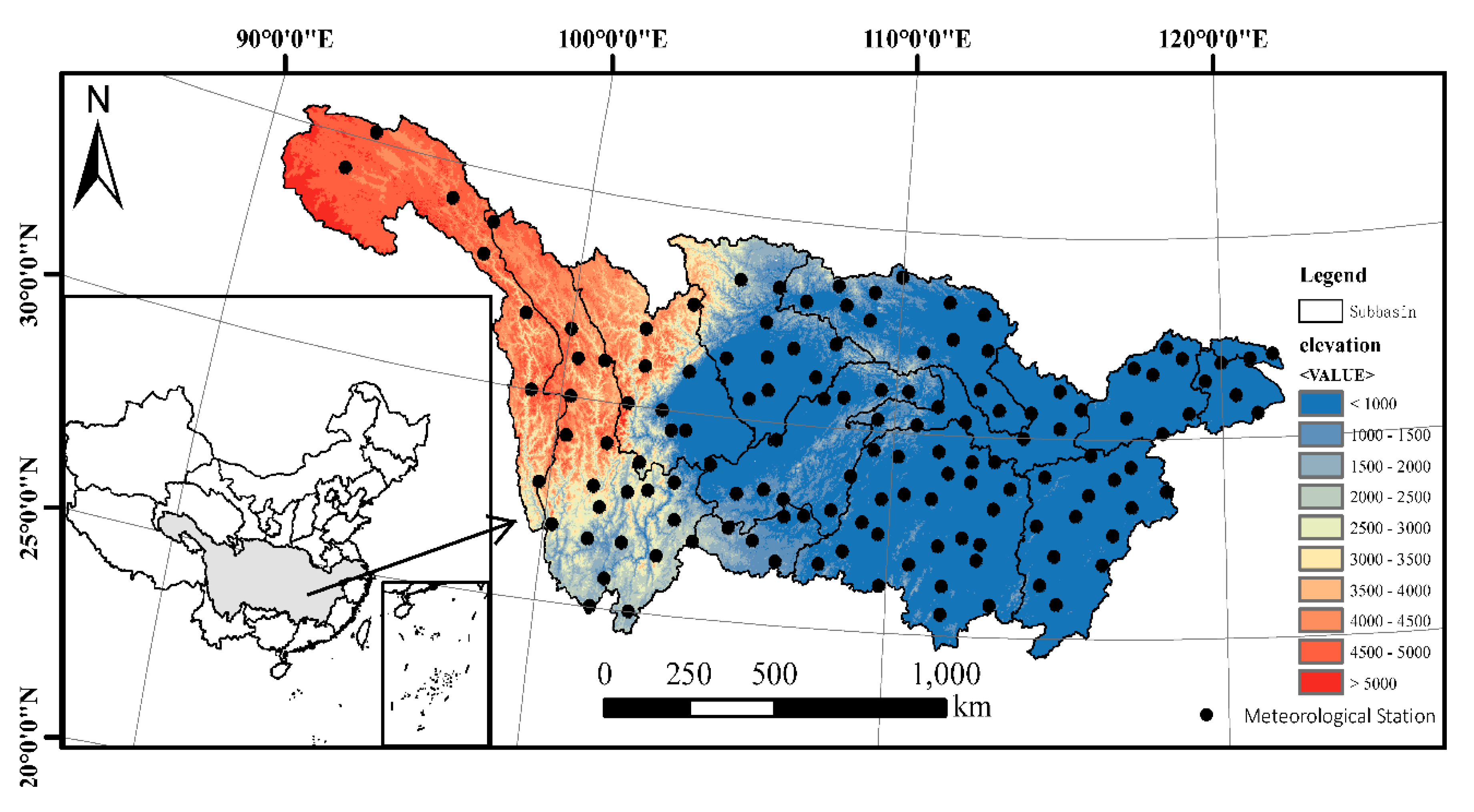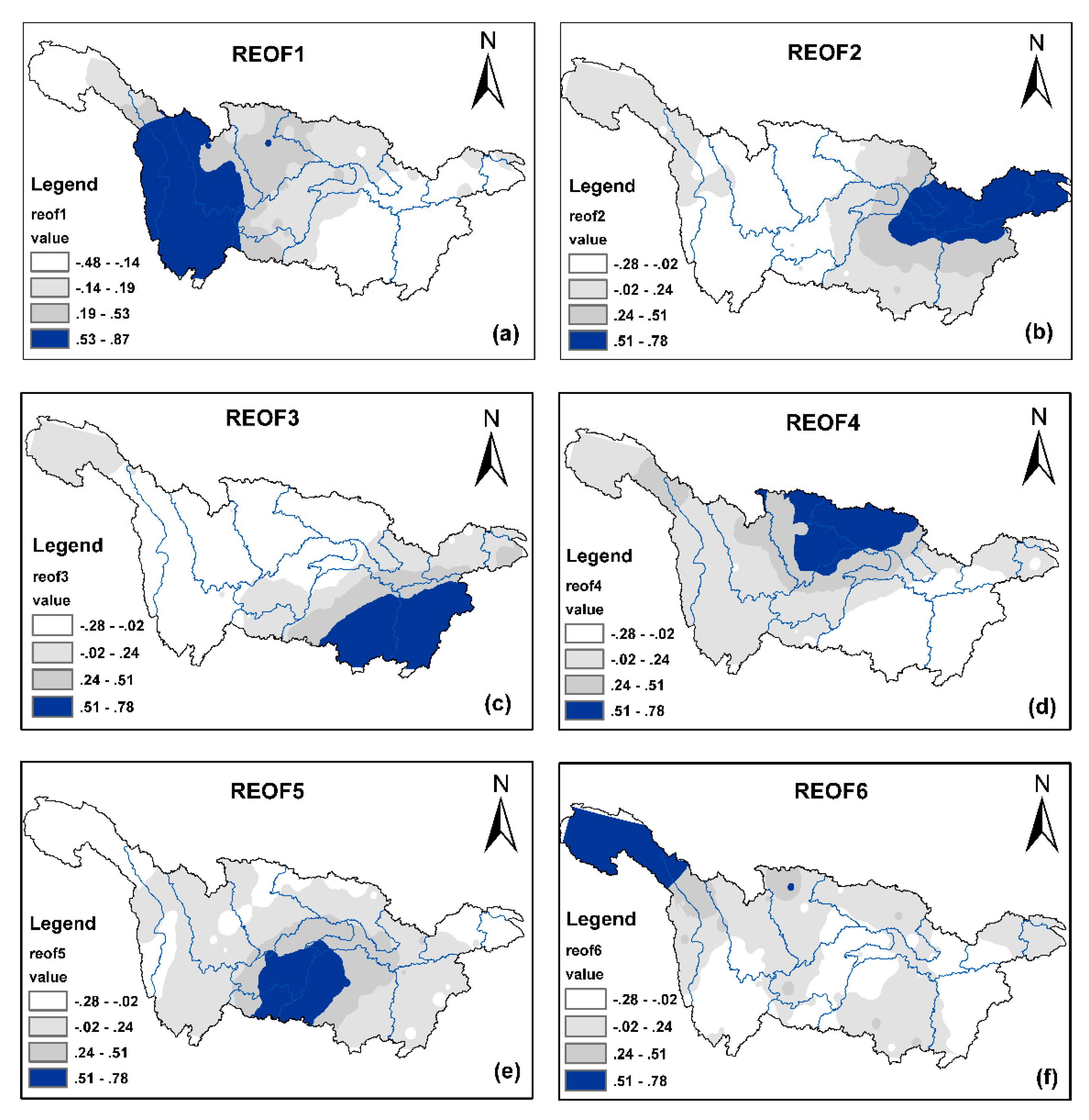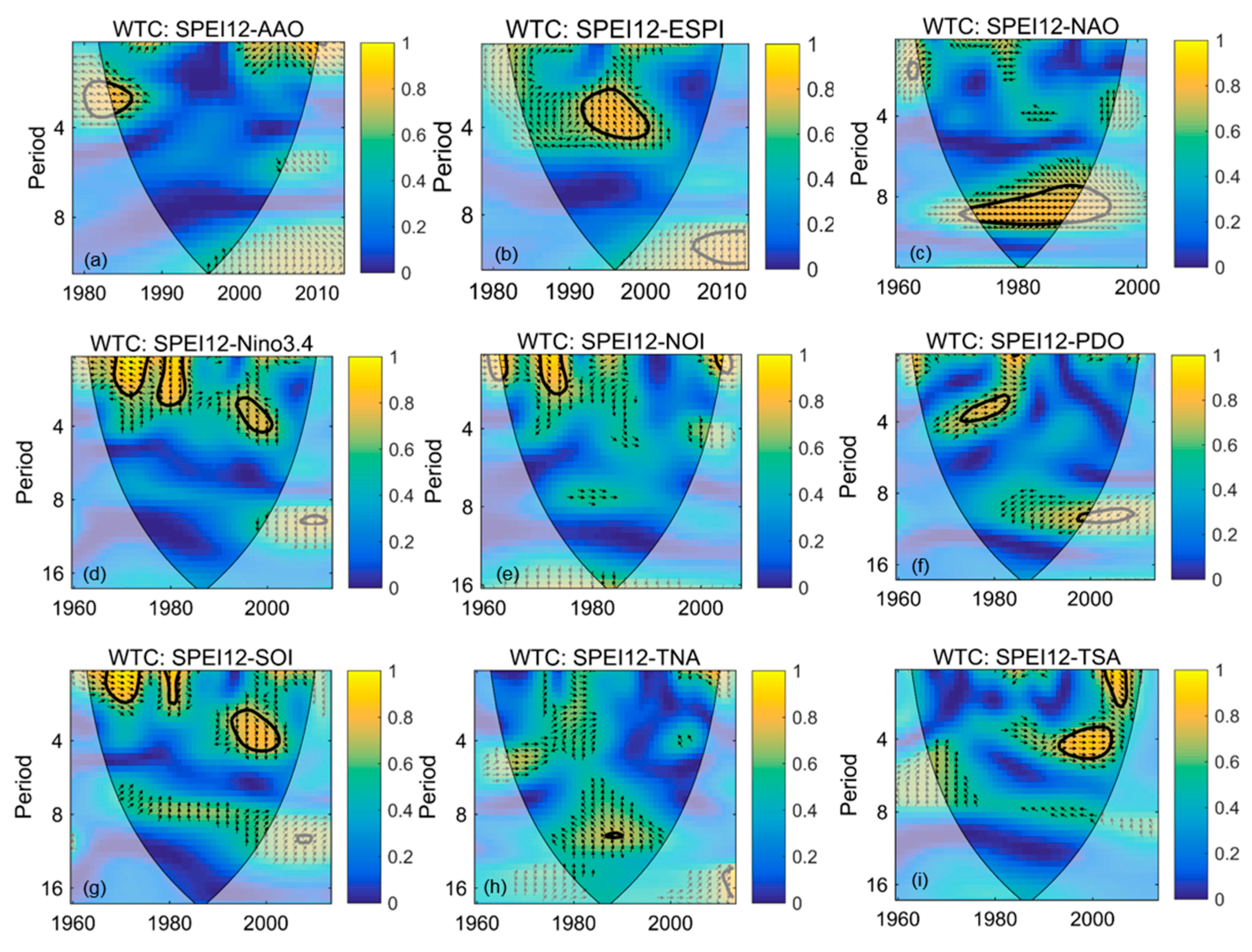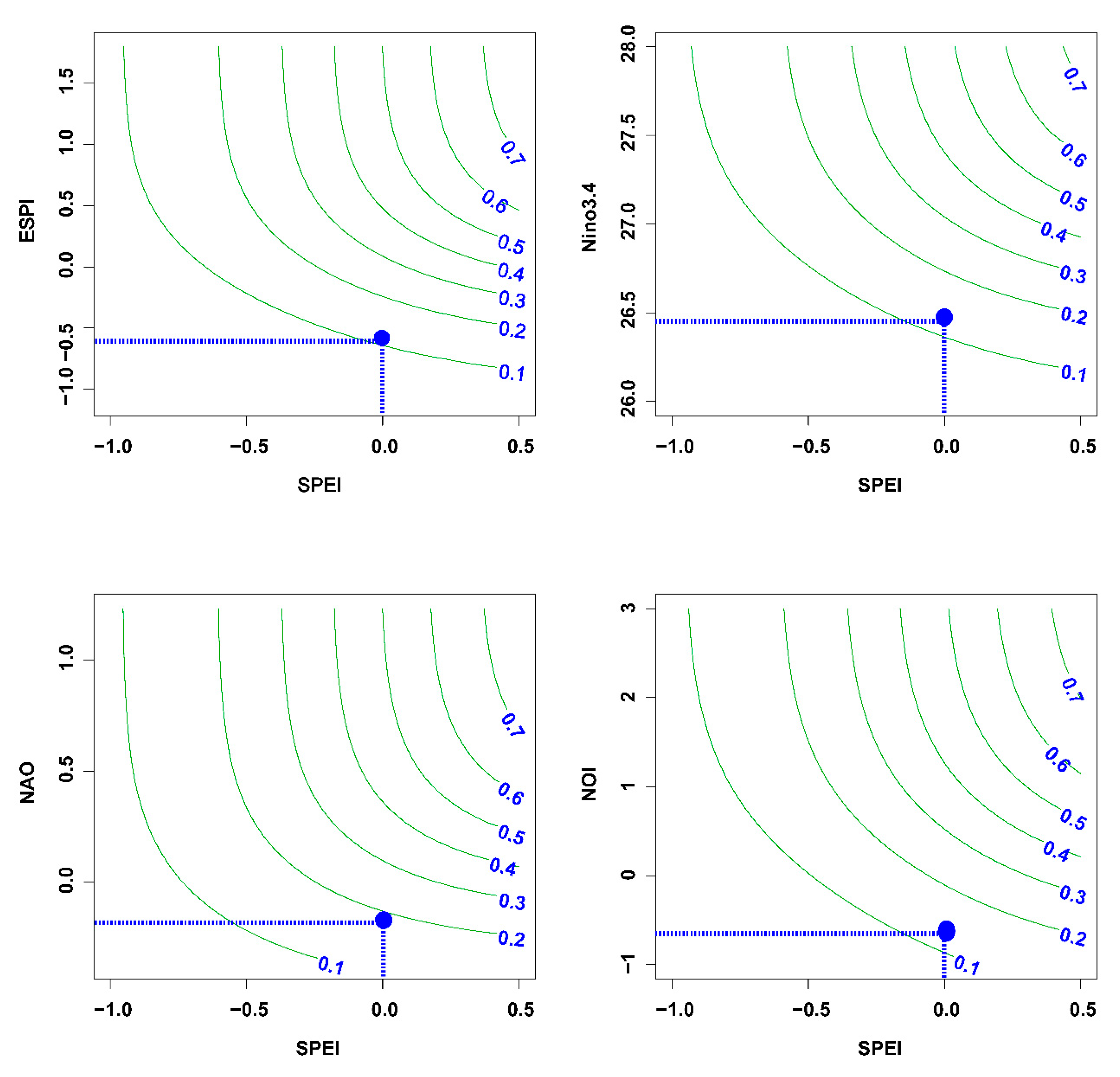Drought Characteristics and Its Response to the Global Climate Variability in the Yangtze River Basin, China
Abstract
1. Introduction
2. Study Area and Data
3. Methods
3.1. SPEI
3.2. EOF/REOF Method
3.3. Wavelet and Lag Analysis
3.4. Copulas
4. Results and Discussion
4.1. Spatial Characteristics of the Drought-Wet Regime in the YRB
4.2. The Correlation Relationship between Drought and the GCV
4.3. The Quantitative Relationship between Drought Events in the YRB and Global Change
5. Conclusions
Author Contributions
Acknowledgments
Conflicts of Interest
References
- Zhao, M.; Running, S.W. Drought-induced reduction in global terrestrial net primary production from 2000 through 2009. Science 2010, 329, 940–943. [Google Scholar] [CrossRef] [PubMed]
- AghaKouchak, A.; Farahmand, A.; Melton, F.S.; Teixeira, J.; Anderson, M.C.; Wardlow, B.D.; Hain, C.R. Remote sensing of drought: Progress, challenges and opportunities. Rev. Geophys. 2015, 53, 452–480. [Google Scholar] [CrossRef]
- Awange, J.L.; Schumacher, M.; Forootan, E.; Heck, B. Exploring hydro-meteorological drought patterns over the greater horn of africa (1979–2014) using remote sensing and reanalysis products. Adv. Water Resour. 2016, 94, 45–59. [Google Scholar] [CrossRef]
- Dai, A. Increasing drought under global warming in observations and models. Nat. Clim. Chang. 2012, 3, 52–58. [Google Scholar] [CrossRef]
- Chen, H.P.; Sun, J.Q. Changes in drought characteristics over china using the standardized precipitation evapotranspiration index. J. Clim. 2015, 28, 5430–5447. [Google Scholar] [CrossRef]
- Ye, X.; Li, X.; Xu, C.-Y.; Zhang, Q. Similarity, difference and correlation of meteorological and hydrological drought indices in a humid climate region—The poyang lake catchment in china. Hydrol. Res. 2016, 47, 1211–1223. [Google Scholar] [CrossRef]
- Zhang, X.; Li, Y.; Yu, G.; Zhang, Q. Runoff simulation and response to climate changes for poyang basin during the past 1000 years. J. Lake Sci. 2016, 28, 887–898. [Google Scholar]
- Awan, U.K.; Liaqat, U.W.; Choi, M.; Ismaeel, A. A SWAT modeling approach to assess the impact of climate change on consumptive water use in Lower Chenab Canal area of Indus basin. Hydrol. Res. 2016, 47, 1025–1037. [Google Scholar] [CrossRef]
- Panagoulia, D.; Dimou, G. Definition and effects of droughts. In Proceedings of the Conference on Mediterranean Water Policy: Building on Existing Experience, Mediterranea Water Network, Valencia, Spain, April 1998. [Google Scholar]
- Dai, A. Characteristics and trends in various forms of the palmer drought severity index during 1900–2008. J. Geophys. Res. 2011, 116, 1248–1256. [Google Scholar] [CrossRef]
- Mishra, A.K.; Singh, V.P. A review of drought concepts. J. Hydrol. 2010, 391, 202–216. [Google Scholar] [CrossRef]
- Jiang, T.; Zhang, Q.; Zhu, D.M.; Wu, Y.J. Yangtze floods and droughts (China) and teleconnections with ENSO activities (1470–2003). Quatern. Int. 2006, 144, 29–37. [Google Scholar]
- Pui, A.; Sharma, A.; Santoso, A.; Westra, S. Impact of the EI Niño-Southern Oscillation, Indian Ocean dipole, and southern annular mode on daily to subdaily rainfall characteristics in east Australia. Mon. Weather Rev. 2012, 140, 1665–1682. [Google Scholar] [CrossRef]
- Santos, J.F.; Portela, M.M.; Pulido-Calvo, I. Spring drought prediction based on winter NAO and global SST in Portugal. Hydrol. Process. 2014, 28, 1009–1024. [Google Scholar] [CrossRef]
- Dai, A.; Trenberth, K.E.; Qian, T.T. A global dataset of palmer drought severity index for 1870–2002: Relationship with soil moisture and effects of surface warming. J. Hydrometeorol. 2004, 5, 1117–1130. [Google Scholar] [CrossRef]
- Sheffield, J.; Wood, E.F. Projected changes in drought occurrence under future global warming from multi-model, multi-scenario, IPCC Ar4 simulations. Clim. Dynam. 2008, 31, 79–105. [Google Scholar] [CrossRef]
- Vicente-Serrano, S.M.; Begueria, S.; Lopez-Moreno, J.I. A multiscalar drought index sensitive to global warming: The standardized precipitation evapotranspiration index. J. Clim. 2010, 23, 1696–1718. [Google Scholar] [CrossRef]
- Vicente-Serrano, S.M.; Begueria, S.; Lopez-Moreno, J.I.; Angulo, M.; El Kenawy, A. A new global 0.5 degrees gridded dataset (1901–2006) of a multiscalar drought index: Comparison with current drought index datasets based on the Palmer Drought Severity Index. J. Hydrometeorol. 2010, 11, 1033–1043. [Google Scholar] [CrossRef]
- Bernstein, L.; Bosch, P.; Canziani, O.; Chen, Z.; Christ, R.; Davidson, O.; Hare, W.; Huq, S.; Karoly, D.; Kattsov, V. Contribution of working groups I, II and III to the Fourth Assessment Report of the Intergovernmental Panel on Climate Change; Synthesis Report; Intergovernmental Panel on Climate Change: Geneva, Switzerland, 2007. [Google Scholar]
- Meehl, G.A.; Tebaldi, C.; Teng, H.; Peterson, T.C. Current and future us weather extremes and EI NIÑO. Geophys. Res. Lett. 2007, 34. [Google Scholar] [CrossRef]
- Zhou, H.; Liu, Y. SPI based meteorological drought assessment over a humid basin: Effects of processing schemes. Water 2016, 8, 373. [Google Scholar] [CrossRef]
- Zhang, X.Q.; Yamaguchi, Y. Characterization and evaluation of MODIS-derived Drought Severity Index (DSI) for monitoring the 2009/2010 drought over southwestern China. Nat. Hazards 2014, 74, 2129–2145. [Google Scholar] [CrossRef]
- Moreira, E.E.; Coelho, C.A.; Paulo, A.A.; Pereira, L.S.; Mexia, J.T. SPI-based drought category prediction using loglinear models. J. Hydrol. 2008, 354, 116–130. [Google Scholar] [CrossRef]
- Begueria, S.; Vicente-Serrano, S.M.; Reig, F.; Latorre, B. Standardized precipitation evapotranspiration index (SPEI) revisited: Parameter fitting, evapotranspiration models, tools, datasets and drought monitoring. Int. J. Climatol. 2014, 34, 3001–3023. [Google Scholar] [CrossRef]
- Wang, Z.; Huang, Z.; Li, J.; Zhong, R.; Huang, W. Assessing impacts of meteorological drought on vegetation at catchment scale in china based on SPEI and NDVI. Trans. Chin. Soc. Agric. Eng. 2016, 32, 177–186. [Google Scholar]
- Ujeneza, E.L.; Abiodun, B.J. Drought regimes in southern Africa and how well GCMS simulate them. Clim. Dynam. 2015, 44, 1595–1609. [Google Scholar] [CrossRef]
- Wang, W.; Zhu, Y.; Xu, R.G.; Liu, J.T. Drought severity change in china during 1961–2012 indicated by SPI and SPEI. Nat. Hazards 2015, 75, 2437–2451. [Google Scholar] [CrossRef]
- Vicente-Serrano, S.M.; Begueria, S.; Lorenzo-Lacruz, J.; Camarero, J.J.; Lopez-Moreno, J.I.; Azorin-Molina, C.; Revuelto, J.; Moran-Tejeda, E.; Sanchez-Lorenzo, A. Performance of drought indices for ecological, agricultural, and hydrological applications. Earth Interact. 2012, 16. [Google Scholar] [CrossRef]
- Zhang, D.; Chen, P.; Zhang, Q.; Li, X. Copula-based probability of concurrent hydrological drought in the Poyang lake-catchment-river system (China) from 1960 to 2013. J. HydroL. 2017, 553, 773–784. [Google Scholar] [CrossRef]
- Guerfi, N.; Assani, A.A.; Mesfioui, M.; Kinnard, C. Comparison of the temporal variability of winter daily extreme temperatures and precipitations in southern Quebec (Canada) using the Lombard and Copula methods. Int. J. Climatol. 2015, 35, 4237–4246. [Google Scholar] [CrossRef]
- Salvadori, G.; De Michele, C. Multivariate real-time assessment of droughts via Copula-based multi-site hazard trajectories and fans. J. Hydrol. 2015, 526, 101–115. [Google Scholar] [CrossRef]
- Zhang, L.; Singh, V.P. Bivariate rainfall frequency distributions using archimedean Copulas. J. Hydrol. 2007, 332, 93–109. [Google Scholar] [CrossRef]
- Bargaoui, Z.K.; Bardossy, A. Modeling short duration extreme precipitation patterns using Copula and generalized maximum pseudo-likelihood estimation with censoring. Adv. Water Resour. 2015, 84, 1–13. [Google Scholar] [CrossRef]
- Mu, W.; Yu, F.; Xie, Y.; Liu, J.; Li, C.; Zhao, N. The Copula function-based probability characteristics analysis on seasonal drought & flood combination events on the North China Plain. Atmosphere 2014, 5, 847–869. [Google Scholar]
- Ye, X.; Xu, C.-Y.; Li, Y.; Li, X.; Zhang, Q. Change of annual extreme water levels and correlation with river discharges in the middle-lower Yangtze River: Characteristics and possible affecting factors. Chin. Geogr. Sci. 2017, 27, 325–336. [Google Scholar] [CrossRef]
- Chen, J.; Wu, X.D.; Finlayson, B.L.; Webber, M.; Wei, T.Y.; Li, M.T.; Chen, Z.Y. Variability and trend in the hydrology of the Yangtze River, China: Annual precipitation and runoff. J. Hydrol. 2014, 513, 403–412. [Google Scholar] [CrossRef]
- Wang, Z.; Wei, G.; Chen, J.; Liu, Y.; Ma, J.; Xie, L.; Deng, W.; Ke, T. El Nifio-Southern Oscillation variability recorded in estuarine sediments of the Changjiang River, China. Quat. Int. 2017, 441, 18–28. [Google Scholar] [CrossRef]
- Zhang, Z.; Chen, X.; Xu, C.-Y.; Hong, Y.; Hardy, J.; Sun, Z. Examining the influence of river-lake interaction on the drought and water resources in the Poyang lake basin. J. Hydrol. 2015, 522, 510–521. [Google Scholar] [CrossRef]
- Zhang, D.; Hong, H.Y.; Zhang, Q.; Li, X.H. Attribution of the changes in annual streamflow in the Yangtze River Basin over the past 146 years. Theor. Appl. Climatol. 2015, 119, 323–332. [Google Scholar] [CrossRef]
- Gu, H.; Yu, Z.; Wang, G.; Wang, J.; Ju, Q.; Yang, C.; Fan, C. Impact of climate change on hydrological extremes in the Yangtze River Basin, China. Stoch. Environ. Res. Risk Assess. 2014, 29, 693–707. [Google Scholar] [CrossRef]
- Xu, C.Y.; Gong, L.B.; Jiang, T.; Chen, D.L.; Singh, V.P. Analysis of spatial distribution and temporal trend of reference evapotranspiration and pan evaporation in Changjiang (Yangtze River) catchment. J. Hydrol. 2006, 327, 81–93. [Google Scholar] [CrossRef]
- Fan, H.; Xu, L.; Tao, H.; Feng, W.; Cheng, J.; You, H. Accessing the difference in the climate elasticity of runoff across the Poyang Lake Basin, China. Water 2017, 9, 135. [Google Scholar] [CrossRef]
- NOAA ESRL Physical Sciences Division Home Page. Available online: http://www.esrl.noaa.gov/psd/ (accessed on 15 November 2017).
- Thornthwaite, C.W. An approach toward a rational classification of climate. Geogr. Rev. 1948, 38, 55–94. [Google Scholar] [CrossRef]
- Penman, H.L.; Keen, B.A. Natural evaporation from open water, bare soil and grass. Proc. R. Soc. Lond. A 1948, 193, 120–145. [Google Scholar]
- Monteith, J.L. Evaporation and Environment, Proceedings of the 19th Symposia of the Society for Experimental Biology, New York, NA, USA, 19–23 September 1964; Fogg, G.E., Ed.; Cambridge University Press: New York, NY, USA, 1965; pp. 205–234. [Google Scholar]
- Van der Schrier, G.; Jones, P.D.; Briffa, K.R. The sensitivity of the PDSI to the thornthwaite and Penman–Monteith parameterizations for potential evapotranspiration. J. Geophys. Res. 2011, 116. [Google Scholar] [CrossRef]
- The Food and Agriculture Organization Irrigation and Drainage Paper 56 Document. Available online: http://www.fao.org/land-water/databases-and-software/eto-calculator/en/ (accessed on 1 January 2018).
- The R Project for Statistical Computing Home Page. Available online: https://www.r-project.org/ (accessed on 5 January 2018).
- The Comprehensive R Archive Network Home Page. Available online: https://cran.r-project.org/ (accessed on 5 January 2018).
- Liu, Y.; Wu, G. Hydroclimatological influences on recently increased droughts in China’s largest freshwater lake. Hydrol. Earth Syst. Sci. 2016, 20, 93–107. [Google Scholar] [CrossRef]
- Zhou, H.; Liu, Y. Spatio-temporal pattern of meteorological droughts and its possible linkage with climate variability. Int. J. Climatol. 2017, 38, 2082–2096. [Google Scholar] [CrossRef]
- Joe, H. Multivariate Models and Multivariate Dependence Concepts; CRC Press: Boca Raton, FL, USA, 1997. [Google Scholar]
- Frees, E.W.; Valdez, E.A. Understanding relationships using Copulas. North Am. Actuar. J. 1998, 2, 1–25. [Google Scholar] [CrossRef]
- Demarta, S.; McNeil, A.J. The t Copula and related Copulas. Int. statist. Rev. 2005, 73, 111–129. [Google Scholar] [CrossRef]
- Cherubini, U.; Luciano, E.; Vecchiato, W. Copula Methods in Finance; John Wiley & Sons: Hoboken, NJ, USA, 2004. [Google Scholar]
- Shen, B.-Z.; Zhang, S.-X.; Yang, H.-W.; Wang, K.; Feng, G.-L. Analysis of characteristics of a sharp turn from drought to flood in the middle and lower reaches of the Yangtze River in spring and summer in 2011. Acta Phys. Sin. 2012, 61, 109202–109213. (In Chinese) [Google Scholar]
- Zhang, Y.; You, Q.; Ye, L.; Chen, C. Spatio-temporal characteristics and possible mechanisms of rainy season precipitation in Poyang Lake Basin, China. Clim. Res. 2017, 72, 129–140. [Google Scholar] [CrossRef]
- Chan, J.C.; Zhou, W. PDO, ENSO and the early summer monsoon rainfall over south China. Geophys. Res. Lett. 2005, 32. [Google Scholar] [CrossRef]
- Xiao, M.; Zhang, Q.; Singh, V.P. Influences of ENSO, NAO, IOD and PDO on seasonal precipitation regimes in the Yangtze River Basin, China. Int. J. Climat. 2015, 35, 3556–3567. [Google Scholar] [CrossRef]
- Wu, B.; Zhou, T. Relationships between ENSO and the East Asian-western North Pacific monsoon: Observations versus 18 CMIP5 models. Clim. Dyn. 2015, 46, 729–743. [Google Scholar] [CrossRef]
- Hurrell, J.W. Decadal trends in the North Atlantic Oscillation: Regional temperatures and precipitation. Science 1995, 269, 676–679. [Google Scholar] [CrossRef] [PubMed]
- Liu, X.; Yin, Z.-Y. Spatial and temporal variation of summer precipitation over the eastern Tibetan Plateau and the North Atlantic Oscillation. J. Clim. 2001, 14, 2896–2909. [Google Scholar] [CrossRef]
- Baohua, R.; Ronghui, H. Interannual variability of the convective activities associated with the East Asian summer monsoon obtained from TBB variability. Adv. Atmos. Sci. 1999, 16, 77–90. [Google Scholar] [CrossRef]
- Genest, C.; Rivest, L.-P. Statistical inference procedures for bivariate Archimedean Copulas. J. Am. Statist. Assoc. 1993, 88, 1034–1043. [Google Scholar] [CrossRef]
- Genest, C.; Favre, A.C. Everything you always wanted to know about Copula modeling but were afraid to ask. J. Hydrol. Eng. 2007, 12, 347–368. [Google Scholar] [CrossRef]
- Hurrell, J.W. Influence of variations in extratropical wintertime teleconnections on northern hemisphere temperature. Geophys. Res. Lett. 1996, 23, 665–668. [Google Scholar] [CrossRef]
- Erhardt, T.M.; Czado, C. Standardized drought indices: A novel univariate and multivariate approach. J. R. Stat. Soc. Ser. C Appl. Stat. 2018, 67, 643–664. [Google Scholar] [CrossRef]
- Bhuyan-Erhardt, U.; Erhardt, T.M.; Laaha, G.; Zang, C.; Parajka, J.; Menzel, A. Validation of drought indices using environmental indicators: Streamflow and carbon flux data. Agr. Forest. Meteorol. 2019, 265, 218–226. [Google Scholar] [CrossRef]








| Abbreviation | Index Name | Period | Data Source |
|---|---|---|---|
| AAO | Antarctic Oscillation | 1979–2016 | NOAA |
| ESPI | ENSO precipitation index | 1979–2016 | NOAA |
| NAO | North Atlantic Oscillation | 1948–2001 | NOAA |
| Nino3.4 | East Central Tropical Pacific SST | 1948–2017 | NOAA |
| NOI | Northern Oscillation Index | 1948–2007 | NOAA |
| PDO | Pacific Decadal Oscillation | 1948–2017 | NOAA |
| SOI | Southern Oscillation Index | 1948–2017 | NOAA |
| TNA | Tropical Northern Atlantic | 1948–2017 | NOAA |
| TSA | Tropical Southern Atlantic | 1948–2017 | NOAA |
| Copula | Parameters | SPEI-ESPI | SPEI-NAO | SPEI-Nino3.4 | SPEI-NOI |
|---|---|---|---|---|---|
| GH | tau | 0.01 | 0.16 | −0.01 | -0.09 |
| theta | 1.01 | 1.20 | ** | ** | |
| p-value | 0.67 | 0.27 | ** | ** | |
| Clayton | tau | 0.01 | 0.16 | −0.01 | −0.09 |
| theta | 0.02 | 0.39 | ** | ** | |
| p-value | 0.96 | 0.16 | ** | ** | |
| AMH | tau | 0.01 | 0.16 | −0.01 | −0.09 |
| theta | 0.05 | 0.61 | −0.03 | −0.48 | |
| p-value | 0.94 | 0.17 | 0.66 | 0.64 | |
| FRANK | tau | 0.01 | 0.16 | −0.01 | −0.09 |
| theta | 0.11 | 1.51 | −0.07 | −0.76 | |
| p-value | 0.97 | 0.35 | 0.69 | 0.84 |
| Variables | Margin Distribution | Location | Scale |
|---|---|---|---|
| SPEI | logistic | −0.02 | 0.43 |
| ESPI | logistic | −0.06 | 0.41 |
| NAO | logistic | 0.08 | 0.27 |
| Nino3.4 | logistic | 26.89 | 0.38 |
| NOI | logistic | 0.06 | 0.78 |
| The GCV Indices | Threshold | SPEI | |
|---|---|---|---|
| <0 | <0.5 | ||
| ESPI | <1/4 | 12% | 6% |
| >3/4 | 10% | 10% | |
| Nino3.4 | <1/4 | 11% | 5% |
| >3/4 | 12% | 12% | |
| NAO | <1/4 | 16% | 9% |
| >3/4 | 8% | 8% | |
| NOI | <1/4 | 11% | 5% |
| >3/4 | 21% | 21% | |
© 2018 by the authors. Licensee MDPI, Basel, Switzerland. This article is an open access article distributed under the terms and conditions of the Creative Commons Attribution (CC BY) license (http://creativecommons.org/licenses/by/4.0/).
Share and Cite
Huang, T.; Xu, L.; Fan, H. Drought Characteristics and Its Response to the Global Climate Variability in the Yangtze River Basin, China. Water 2019, 11, 13. https://doi.org/10.3390/w11010013
Huang T, Xu L, Fan H. Drought Characteristics and Its Response to the Global Climate Variability in the Yangtze River Basin, China. Water. 2019; 11(1):13. https://doi.org/10.3390/w11010013
Chicago/Turabian StyleHuang, Tao, Ligang Xu, and Hongxiang Fan. 2019. "Drought Characteristics and Its Response to the Global Climate Variability in the Yangtze River Basin, China" Water 11, no. 1: 13. https://doi.org/10.3390/w11010013
APA StyleHuang, T., Xu, L., & Fan, H. (2019). Drought Characteristics and Its Response to the Global Climate Variability in the Yangtze River Basin, China. Water, 11(1), 13. https://doi.org/10.3390/w11010013






